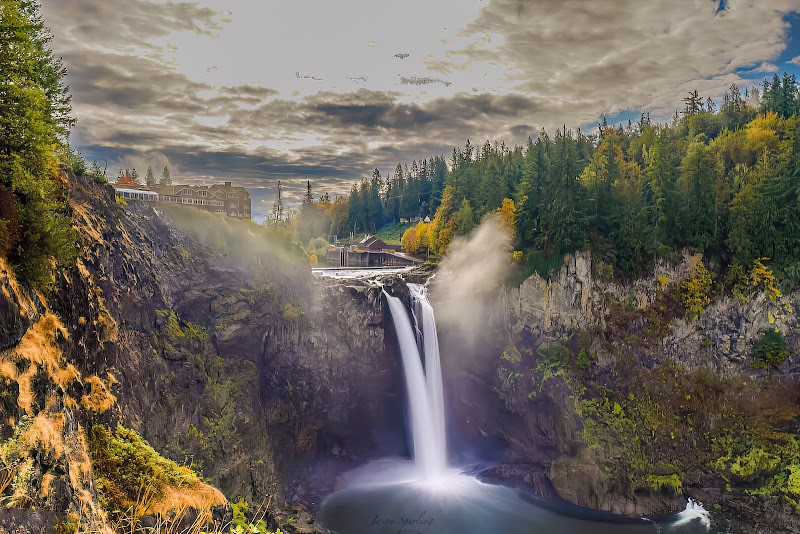
Snoqualmie Falls: A Practical Guide to Washington’s Majestic Waterfall Adventure
Snoqualmie Falls offers more than just a waterfall view—it delivers an adventurous encounter with one of Washington’s most powerful natural forces. Discover practical advice and sensory highlights to plan your visit, whether you seek a peaceful lookout or a short, invigorating hike.
Choose sturdy footwear
The trails feature uneven roots and occasional slick sections; shoes with good grip will keep you steady and confident.
Bring adequate water
Even a short hike can be demanding with its elevation changes; hydration keeps your energy steady, especially during warmer months.
Visit early or late in the day
Crowds thin out and lighting improves, giving you a more intimate and visually rewarding experience at the overlook.
Prepare for weather changes
Rain is common in the Pacific Northwest, so layered clothing and waterproof gear ensure comfort and safety on damp trails.
Snoqualmie Falls: A Practical Guide to Washington’s Majestic Waterfall Adventure
Snoqualmie Falls roars with a fierce presence just 28 miles east of Seattle, daring you to step close and feel its energy. This 268-foot waterfall doesn’t just cascade—it commands the Snoqualmie River, pushing forward in a relentless rush that shapes the landscape and the experience. The main viewpoint is easily accessible—a paved path leads to an overlook where the falls explode into view, framed by evergreen forests that guard the edges.
For those wanting more than a glimpse, the Snoqualmie Falls trail extends along forested ridges and steep descents, about 1.5 miles round trip with an elevation change near 400 feet. The terrain demands sturdy footwear; roots and slick rocks are reminders that nature here stays fiercely itself. Along the way, the forest breathes around you: firs tower overhead while the river’s roar pulses through the air, a constant, wild heartbeat.
Timing your visit is key. Early morning or late afternoon promises softer light and fewer crowds, letting you soak in the falls’ raw power without distraction. Summer brings busy weekends, but also warmer weather and clearer trails, while spring’s swollen river amplifies the falls’ thunderous voice.
Practical tips matter here: bring water to match the physical demands, wear grippy shoes for safety, and prepare for varying weather—rain can shift the trail from challenge to hazard. The falls are more than a destination; they're a reminder of an ongoing dialogue with a force that shapes the earth beneath your feet.
Nearby, the Salish Lodge offers a chance to unwind with a view that stretches beyond the falls, perfect after your outdoor quest. Whether it’s a quick visit or an extended exploration along connected trails, Snoqualmie Falls invites you to meet a natural giant on its own terms.
Nearby Trips
All Adventures
Boat Charters
Water Activities
Adventures near Seattle, Washington
Discover the unique and memorable adventures that make Seattle, Washington special.
Frequently Asked Questions
Is there an entrance fee to visit Snoqualmie Falls?
No entrance fee is required to access the main Snoqualmie Falls viewpoint or the nearby trails. Parking may have a small fee depending on the season and management policies.
Can I hike down to the base of the falls?
There is no official trail that leads directly to the base of the falls due to steep and dangerous terrain. Visitors are encouraged to enjoy designated viewpoints for safety.
Are dogs allowed on the trails?
Dogs are permitted but must be kept on a leash at all times to protect local wildlife and other visitors.
What wildlife might I encounter during the hike?
Visitors can spot birds such as bald eagles and woodpeckers, as well as smaller mammals like squirrels and occasionally river otters near water.
Is the trail wheelchair accessible?
The main overlook area and parking are wheelchair accessible, but the trails involving elevation changes and rough terrain are not suitable for wheelchairs.
When is the best time to photograph the falls?
Early morning or late afternoon offers the best natural light and fewer visitors, ideal for capturing vibrant colors and dynamic water flow.
Recommended Gear
Waterproof hiking shoes
Keeps feet dry and steady on wet or muddy sections common especially in fall and winter.
Reusable water bottle
Hydration is key regardless of season for a safe and enjoyable hike.
Layered clothing
Allows quick adjustments to changing temperatures and rain showers typical of spring weather.
Camera or smartphone
Captures the dramatic drop of the falls and forest textures during your visit.
Local Insights
Hidden Gems
- "The less-visited Twin Falls viewpoint, a short drive from Snoqualmie Falls, offers a quieter waterfall experience."
- "Look for the river’s rock gardens downstream where currents form striking natural patterns."
Wildlife
- "Keep an eye out for bald eagles circling above especially in late fall and winter."
- "River otters occasionally make appearances near calmer pools below the falls."
History
"Snoqualmie Falls holds deep cultural significance to the Snoqualmie Tribe, who consider it a sacred site and a place of spiritual power."
